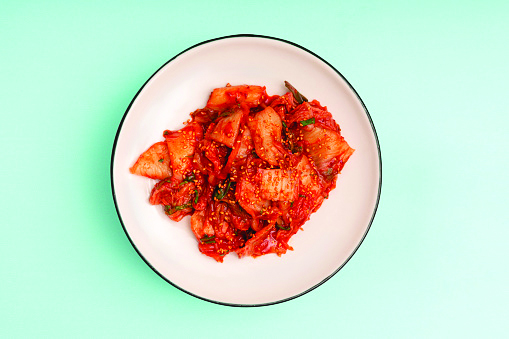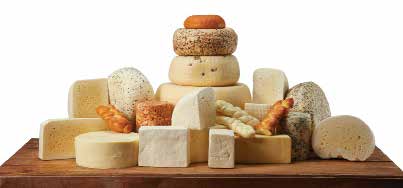SAZERAC

Sage Gardener

My introduction to kimchi was via M*A*S*H, when Frank Burns boasts about catching some Korean peasants burying a land mine — which turns out to be a vat of kimchi. Upon excavation, Hawkeye takes his own dig at Burns, saying “You’ve struck coleslaw!”
Actually, it’s rather surprising that the usually wellinformed M*A*S*H writers should mention slaw. Fermented and aged (traditionally underground to control the temperature) for a month or more, kimchi doesn’t vaguely resemble coleslaw. Think of a nostril-bending flavor bomb made with fermented cabbage, spiked with chilies, ginger and garlic.
My next encounter with kimchi was on the end of a fork in Cocoa, Florida, where I was writing about the space shuttle’s efforts to escape Earth’s gravity. An editor who had hitchhiked across Asia served it with warm sake one night — love at first bite. I was soon fermenting my own, filling the house with a thick aroma. Another reporter and I would get up at daybreak and catch a mess of mullet, which my wife, Anne, would fry and serve with grits and kimchi. The reporter and I still say it’s the best breakfast we ever had.
Since pickling vegetables is an ideal method of extending their lifespan, kimchi making in Korea dates back to well before the Christian Era. But forget the chilies. Chili peppers, native to the Americas, didn’t make it to Korea until the 1600s.
Most of the kimchi available in America is made from Napa cabbage and scallions, sometimes with added fish sauce. Authentic Korean kimchi often contains salted shrimp or croaker — or other finny prey, including anchovies and salted cod gills.
I’ve found that kimchi tends to appeal to people who relish the strongest of flavors. A friend who obsessively made beer for a while, transitioned to kimchi, observing that he became “fascinated by the alchemy of salt turning bland vegetables into hot, sour yumminess.” Plus, he hoped it “would nurture my gut and cure what age and various vices had inflicted on me.” Like other fermented foods, kimchi’s teeming bacteria is purportedly good for your intestinal microbiome. But people eat kimchi because they love how it triggers endorphins, generally appealing to the same people who fall in love with tonguenumbing hot sauces, hopcrazy IPA’s, mind-bending mescals and peaty, smoky Isla scotch.
Making kimchi is as easy as making sauerkraut and there are a plethora of recipes on the internet. As the days grow colder, consider starting a batch, especially if you have cabbage in your garden. There’s something magical about having a batch of kimchi bubbling away in a dark room, getting a little more sour with each passing day, a little hotter and a little more redolent. Get started now and it will make a great gift under the tree — festively green and red — and mask that annoying evergreen scent.
— David Claude Bailey
Letters
To Cassie Bustamante in response to her June 2024 column, “Curb Alert”
As I sit here in my yard chair relaxing after a morning of delayed yard work, I am enjoying the June edition of O.Henry magazine.
Your article brings back memories. Christmas 2003, my son received his first car as a present. It was a 1998 Jeep Cherokee.
The thought being, it would help in having another driver, helping with errands, stopping his mother and I being his chauffeur. Wrong!
However, that’s not the story at hand.
I remember that Christmas Day going out for a drive with my son Nick at the helm. He decided that a ride on the highway I-40 would be a good idea to test out his new ride.
I have never been so scared sh&$less in my entire life. All I could do was pray and hope to get home in one piece.
Finally he pulled into the driveway and, forgetting to put the Jeep in park, he hit the rear bumper of my wife’s Mercury.
We did have a happy ending though. The Mercury was a tank, no visible damage to either vehicle.
Reading your article brought back this now humorous incident to mind.
Our kids, no matter what they do, leave us with memories. Hopefully, good ones.
— David Ruden
The Passed Baton

“You Should Be Dancing,” the Greensboro Symphony Orchestra has decided — and with a new Aussie conductor as your dance master. Christopher Dragon will take the baton on September 14 to lead the symphony in a POPS Concert featuring The Australian Bee Gees Show, a tribute to the legendary group, at the Tanger Center. Bellbottoms optional.
During its last season, dubbed “Season of the Seven,” seven candidates auditioned — each having an opportunity to lead the symphony. Dragon won out. Hailing from Perth, Australia, Christopher Dragon began his career in his home country with the West Australia Symphony Orchestra. Since then, he’s led the Colorado Symphony as well as the Wyoming Symphony, and worked with orchestras the world over. Plus, not to name drop — but, just for you music aficionados, we’re going to — he’s collaborated with the likes of Cynthia Erivo, Joshua Bell, the Wu-Tang Clan and Cypress Hill. And he’s stoked to bring his flair to the Gate City while creating “unforgettable symphonic experiences to inspire the next generation of music lovers.”
But wait — there’s more! While there can only be one conductor on the podium at a time, sometimes there’s room for two at the top. Chelsea Tipton, fellow “Season of the Seven” candidate, has been named principal guest conductor. A native of Greensboro, Tipton currently serves as music director of the Symphony of Southeast Texas and principal pops conductor of the New Haven Symphony Orchestra. “Returning to my hometown in this capacity is a dream come true,” he says.
Unsolicited Advice

Did you know that September is National Italian Cheese Month? Grate-est news ever grazie! We support any observance that involves feasting on that melt-in-your-mouth (or on your sandwich) delight, any way you slice it. But preferably with carbs and wine, per favore. Stock up on Lactaid and get ready to dazzle your palate with some of our magnifico varieties!
Gorgonzola: Sounds like an evil character from a 1980s cartoon featuring little blue creatures, but is actually the Italian answer to blue — or, shall we say bleu — cheese. Crumbles easily, just like us.
Mozzarella: Quite possibly the most popular pizza topping due to its meltability. Frankly, we’d eat it as a topper to the cardboard circle frozen pizza comes on in its ooey-gooeiest state. By the way, mozzarella is not related to Cinderella, who is actually French.
Parmigiano-Reggiano: Two first names? Must be from Southern Italy.
Mascarpone: Any cheese that can masca-rade as dessert is a winner in our books. If pizza pie isn’t your thing, how ‘bout a pumpkin-mascarpone pie?
Ricotta: Rick oughta make us his famous lasagne soon. And tell him to use the good stuff — none of that cottage cheese.
Provolone: Between two slices of crusty Italian bread slathered with butter, this one makes a delicious and simple grilled cheese. Ready, set, ciao!
